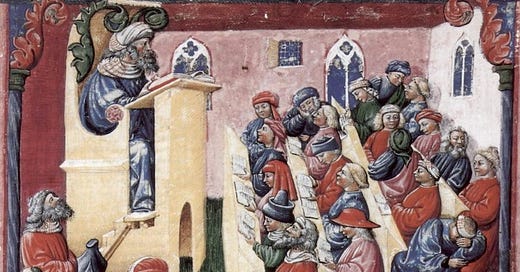High points of medieval culture and thought
Review of The Scholastic Culture of the Middle Ages, 1000-1300 by John W. Baldwin
The scholastics get a bad rap: in both popular media and serious scholarship, they’re viewed as hopeless fools who reason about strange, non-sensical esoterica, jumps of twisted logic that no one in their right mind would be interested in. Indeed, they are portrayed as simply doggedly memorizing these things to no end.
In long conversations with a physicist friend, I came to see them as pioneers of method. Precursors to the endeavor of modern science.
The author starts with an explanation of the political context, the time when in England and France strong monarchs were consolidating power, creating islands of stability and thereby an age of unprecedented prosperity in which far larger urban centers arose, from about 1000 CE. These were the preconditions for an intellectual and artistic flowering known as the scholastic and Gothic age, which declined after 1300 (plague, economic collapse).
Regarding the intellectual progress of the period, I was a bit disappointed in his coverage. I was looking for how the scholastics extended the philosophy of Aristotle's logic in a much more systematic manner, which arguably forms the basis of modern science: discovery and hypothesis, checking against the observations of colleagues (including the incorporation of their criticism), and then recording their conclusions in a definitive text that is widely accepted and later modified in light of new discoveries. Perhaps the most well developed example of this was Aquinis' Summa Theologica, which among other things attempted to logically reconcile every single reference in the Bible.
While Baldwin did describe the development of these methods for theology and law in this period, I was hoping for much more detail, which is why I got the book. The achievement was huge, and an invaluable intellectual precursor to the Renaissance and Enlightenment rather than an approach to be discarded as silly verbiage (the common image of how to count angels on the head of a pin).
Baldwin does explain the conflict between faith and reason that was one of the principal issues of the time – was God the primary source of everything, a supposition to remain unquestionable? Or could truth also be reached independently of God by logic and grammatical analysis? Unfortunately, Baldwin does not offer enough, at least for me, on the limits that the scholastics came up against, i.e., that their long disputations were not sufficiently moored to real-world observation, but instead continued to rely on divine revelation in the Bible for final, irrefutable, proof or the authorities of antiquity or even Islam (Augustine, Aristotle, Averroës, etc.) for the last word. That meant that their arguments remained solidly in the realm of metaphysics, where nothing could be definitely proven or disproven. A dead end.
Nonetheless, their mode of reasoning was well applied by later intellectuals in science, who added more stringent standards for verification that were not ultimately dependent on faith. (If any reader has a suggestion on where to find that in greater depth, I would love to hear from them. I’ve been looking for one for 30 years.)
Baldwin also covers the art of the time, Gothic cathedrals and their sculptures and windows. This too is somewhat light, if very interesting. He sees the cathedrals as an integral part of the impulse to instruction and illumination of the times, incorporating the scholastic method into the carved stone itself. He also gives the context from which the cathedrals sprung, i.e. comparing their differences from Romanesque churches and what they meant. Some architectural innovations of the period are covered, such as the flying buttress and vaulted arches, but again it is superficial.
While I was hungry for more detail, this is indeed a splendid and clear introduction, expertly and elegantly written. This is a basic introduction to this historical era at the undergraduate level.




